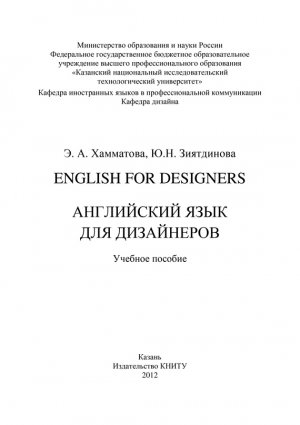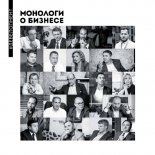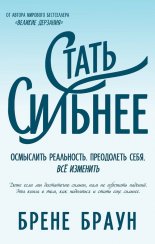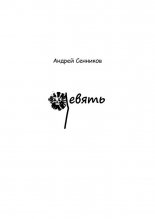English for designers. Английский язык для дизайнеров Зиятдинова Юлия

Введение
Вхождение нашего государства в мировое сообщество, развитие и укрепление межгосударственных политических, экономических и культурных связей, интернационализация всех сфер жизни в стране способствует тому, что иностранные языки становятся реально востребованными в современном обществе. Современный специалист в области дизайна не мыслим без знания иностранных языков. Большая роль в успешном решении этой задачи заключается в умении соотносить языковые средства с конкретными ситуациями, условиями и задачами общения.
Цели учебного пособия:
• подготовка бакалавров в области специализированного перевода с целью повышения профессиональной квалификации;
• выработка практических навыков профессионального (устного и письменного) перевода в сочетании с изучением теории языка и теории перевода;
• углубление знаний по истории развития европейского костюма;
• развитие межкультурной компетенции с целью повышения эффективности межкультурной коммуникации в сфере профессиональной деятельности.
Как известно, изучение иностранного языка включает два важнейших аспекта – когнитивный (способность к умственному восприятию и переработке внешней информации) и коммуникативный (возможность вступать в коммуникации). Без когнитивного элемента, то есть без знания слов, устойчивых фраз и выражений, невозможно перейти к последующим коммуникациям или разговорам на иностранном языке. Именно из слов строятся фразы и предложения, и, поэтому чем больше словарный запас на иностранном языке, тем легче студенту понимать написанный текст и высказывать свои мысли.
Настоящее пособие является основной частью учебно-методического комплекса, предназначенного для обучения английскому языку бакалавров дизайна и искусства костюма и текстиля.
Специфика обучения бакалавров дизайна и искусства костюма и текстиля английскому языку предполагает чтение оригинальной литературы по специальности и ведение беседы на темы профессиональной направленности, предусмотренные программой.
Пособие включает в себя 10 тем и практических занятий, объединенных единой тематикой, а также текстов для домашнего чтения и письменного перевода. В начале каждого занятия представляется лексика по заданной теме, которая способствует формированию знаний лексического минимума общего и терминологического характера. Далее следует информативный текст на английском языке, который сопровождается заданиями для контроля понимания, умения отвечать на вопросы и выражать мысль на английском языке, для совершенствования навыков поискового чтения. В последующих заданиях содержатся тексты и предложения как на английском, так и на русском языке, предназначенные для устного и письменного перевода. Для закрепления полученных знаний в конце каждого урока содержатся задания на формирование речевых навыков как дискуссионного (диалог), так и излагательного характера (пересказ, составление рассказов). Тексты, предложенные для домашнего чтения и письменного перевода, предполагаются для самостоятельной работы студентов.
Данное учебное пособие рассчитано на аудиторную, самостоятельную и индивидуальную работу студентов, обучающихся по программам подготовки 072500.62 «Дизайн» и 072700.62 «Искусство костюма и текстиля».
Unit 1
FASHION DESIGN
1. Прочитайте следующие слова и словосочетания вслух и определите их значение:
aesthetics, accessories, latitudes, clothing, garment, market, consumer, range, combinations, patterns, conventional, occasions, specifically, haute couture, bespoke tailoring, mass market, casual, every-day wear, freelance designer, directly, manufacturers, selfemployed, apparel, muslin, via, precise, painstaking, accuracy, operational outfit, concept, technicality, according, predominantly, ready-to-wear, quantities, customers, kitsch, high-waisted trousers, bridal.
2. Прочитайте и переведите следующие глаголы:
to anticipate, to require, to influence, to attempt, to satisfy, to desire, to consider, to design, to bear, to establish, to sketch, to drape, to satisfy, to depend, to figure out, to split up, to guarantee.
3. Подберите эквивалентный перевод словосочетаний из колонки A в колонке В.
4. Прочитайте и переведите текст.
Fashion design is the art of the application of design and aesthetics or natural beauty to clothing and accessories. Fashion design is influenced by cultural and social latitudes, and has varied over time and place. Fashion designers work in a number of ways in designing clothing and accessories. Some work alone or as part of a team. They attempt to satisfy consumer desire for aesthetically designed clothing; and, because of the time required to bring a garment onto the market, must at times anticipate changing consumer tastes.
Fashion designers attempt to design clothes which are functional as well as aesthetically pleasing. They must consider who is likely to wear a garment and the situations in which it will be worn. They have a wide range and combinations of materials to work with and a wide range of colors, patterns and styles to choose from. Though most clothing worn for everyday wear falls within a narrow range of conventional styles, unusual garments are usually sought for special occasions, such as evening wear or party dresses.
Some clothes are made specifically for an individual, as in the case of haute couture or bespoke tailoring. Today, most clothing is designed for the mass market, especially casual and every-day wear. Fashion designers can work in a number of many ways. Fashion designers may work full-time for one fashion as 'in-house designers' which owns the designs. They may work alone or as part of a team. Freelance designers work for themselves, selling their designs to fashion houses, directly to shops, or to clothing manufacturers. The garments bear the buyer's label. Some fashion designers set up their own labels, under which their designs are marketed. Some fashion designers are self-employed and design for individual clients. Other high-fashion designers cater to specialty stores or high-fashion department stores. These designers create original garments, as well as those that follow established fashion trends. Most fashion designers, however, work for apparel manufacturers, creating designs of men’s, women’s, and children’s fashions for the mass market. Large designer brands which have a 'name' as their brand such as Abercrombie & Fitch, Justice, or Juicy are likely to be designed by a team of individual designers under the direction of a designer director.
Designing a garment. Fashion designers work in different ways. Some sketch their ideas on paper, while others drape fabric on a dress form. When a designer is completely satisfied with the fit of the toile (or muslin), he or she will consult a professional pattern maker who then makes the finished, working version of the pattern out of card or via a computerized system. The pattern maker's job is very precise and painstaking. The fit of the finished garment depends on their accuracy. Finally, a sample garment is made up and tested on a model to make sure it is an operational outfit. Myriam Chalek, owner and founder of Creative Business House explains that most of the time fashion designers only have a fashion concept; the technicality and construction is not thought through during the visual conception and sketching process. Hence, the fashion designer needs to meet with a pattern maker and sample maker to figure out if the sketch on paper can be brought to life according its vision.
Types of fashion. The garments produced by clothing manufacturers fall into three main categories, although these may be split up into additional, more specific categories:
1. Haute couture. Until the 1950s, fashion clothing was predominately designed and manufactured on a made-to-measure or haute couture basis (French for high-sewing), with each garment being created for a specific client. A couture garment is made to order for an individual customer, and is usually made from highquality, expensive fabric, sewn with extreme attention to detail and finish, often using time-consuming, hand-executed techniques. Look and fit take priority over the cost of materials and the time it takes to make.
2. Ready-to-wear (pret-a-porter). Ready-to-wear clothes are a cross between haute couture and mass market. They are not made for individual customers, but great care is taken in the choice and cut of the fabric. Clothes are made in small quantities to guarantee exclusivity, so they are rather expensive. Ready-to-wear collections are usually presented by fashion houses each season during a period known as Fashion Week. This takes place on a city-wide basis and occurs twice a year. The main seasons of Fashion Week include, spring/summer, fall/winter, resort, swim and bridal.
3. Mass market. Currently the fashion industry relies more on mass market sales. The mass market caters for a wide range of customers, producing ready set by the famous names in fashion. They often wait around a season to make sure a style is going to catch on before producing their own versions of the original look. In order to save money and time, they use cheaper fabrics and simpler production techniques which can easily be done by machine. The end product can therefore be sold much more cheaply.
There is a type of design called "kutch" design originated from the German word "kitschig" meaning "ugly" or "not aesthetically pleasing." Kitsch can also refer to "wearing or displaying something that is therefore no longer in fashion." Often, high-waisted trousers, associated with the 1980s, are considered a "kitsch" fashion statement.
(From http://en.wikipedia.org)
5. Закончите предложения, используя следующие слова: fashion, haute couture, mass market, season, garment.
Сasual and every-day wear is designed for …
A … garment is made specifically for the wearer’s measurements and body stance.
They must consider who is likely to wear a … and the situations in which it will be worn.
Some … designers are self-employed and design for individual clients.
Ready-to-wear collections are usually presented by fashion houses each … during a period known as Fashion Week.
6. Сопоставьте следующие понятия:
7. Прочитайте, переведите и озаглавьте текст.
London has long been the capital of the UK fashion industry and has a wide range of foreign designs which have integrated with modern British styles. Typical British design is smart but innovative yet recently has become more and more unconventional, fusing traditional styles with modern techniques. Vintage styles play an important role in the British fashion and styling industry. Stylists regularly 'mix and match' the old with the new, which gives British style that unique, bohemian aesthetic that many of the other fashion capitals try to imitate. Irish fashion (both design and styling) is also heavily influenced by fashion trends from Britain. Famous British brands and designers include Burberry, Alexander McQueen, Mulberry, Stella McCartney and Vivienne Westwood.
(From http://en.wikipedia.org)
8. Переведите следующие предложения письменно.
1. Первым в истории кутюрье традиционно считается модельер, создатель Синдиката Высокой моды Чарльз Фредерик Уорт.
2. С точки зрения искусства мода близка к концептуальному искусству, поскольку она заключается в сочетании различных элементов (прическа, материал одежды, фасон, колор, аксессуары), создающих образ.
3. Мода – это форма безобразия, настолько невыносимого, что мы вынуждены изменять ее каждые полгода. (О. Уайльд).
4. Одежда производится в небольших количествах, чтобы гарантировать эксклюзивность, так что они довольно дорогие.
5. На сегодняшний день наибольшая часть одежды рассчитана на массовый рынок, в особенности для удобной и повседневной носки.
9. Ответьте на вопросы по тексту упражнения 4.
What is the function of fashion designers?
What kind of garments can you name ‘haute couture’?
What type of collections are presented each season during a period known as Fashion Week?
How does Myriam Chalek explain the designing process?
10. Перескажите текст упражнения 4, используя фразы в приложении.
Unit 2
FASHION HISTORY
1. Прочитайте следующие слова вслух и переведите их письменно:
cyclas, sleeves, transition, kittle, floor-length, ankle-length, abundant, doublets, hose, collars, opulence, farthingale, ornamentation, shoulders, waistlines, reveals, petticoats, foreparts, somber, stomachers, breeches, ensembles.
2. Прочитайте и переведите следующие глаголы:
to divert, to inaugurate, to enable, to include, to reflect.
3. Подберите эквивалентный перевод словосочетаний из колонки A в колонке В.
4. Прочитайте и переведите текст.
Clothing throughout the thirteenth century was very simple and varied very little between men and women. A loose-fitting fulllength gown with fitted sleeves worn with a narrow belt and a sleeveless coat called the cyclas was the norm. Until this point, very little diverted from Roman influence.
The fourteenth century inaugurated the Renaissance and brought the first major from simple draped shapes to fitted garments. Contoured seams and the start transition of tailoring techniques now enabled clothing to become more of a sheath around the body. Buttons and lacing allowed for an even closer fit. Women of the time wore an ankle- or floor-length chemise called a cotte, or kittle. The fitted version of the gown worn on top, called a cotehardie, often featured long hanging sleeves. In Europe throughout this period, fashion began to change at an unprecedented pace.
During the fifteenth century Europe experienced an abundant prosperity, the growth of the middle classes, and the development of a skilled workforce. This created an appetite for extravagances. Voluminous gowns called houppelandes featured floor-length sleeves and were worn with doublets, high collars, and hose. Headwear became more important and was trimmed with all manner of feathers and jewels. Everything became more complex and varied by region.
The sixteenth century was characterized by an increased opulence in fashion, most especially in England under Elizabeth I. Some of the atypical fashion details included the lace Tudor ruff, a hoop skirt called a farthingale, and rich surface ornamentation. In sharp contrast to the sloping narrow shoulders of the early 1500s, the Elizabethan court adopted shoulders that were high and wide with narrow sleeves reflecting French and Spanish styles. The shoulders were further enhanced by padded and jeweled shoulder rolls and accentuated by deep V-shaped waistlines. The V shape was mirrored by skirts that opened at the front to display petticoats or heavily decorated foreparts.






